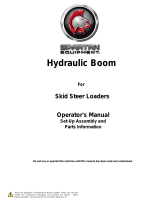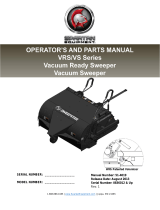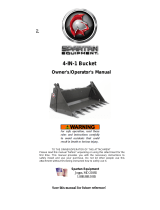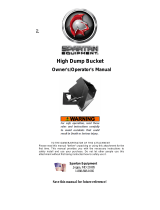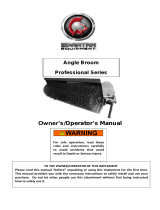Page is loading ...

Notes
2

TABLE OF CONTENTS
INTRODUCTION .......................................................................................................................................................... 4
SAFETY STATEMENTS ............................................................................................................................................... 4
GENERAL SAFETY PRECAUTIONS ........................................................................................................................ 5-6
SAFETY SIGNS & LABELS .......................................................................................................................................... 7
SERVICE & REPAIR - SAFETY ................................................................................................................................... 8
OPERATION ................................................................................................................................................................. 8
STORAGE ................................................................................................................................................................ ..10
PRODUCT INFORMATION ....................................................................................................................................... 11
MAINTENANCE .......................................................................................................................................................... 12
REPLACING BRUSH SECTIONS .............................................................................................................................. 13
MAINTENANCE SCHEDULE ..................................................................................................................................... 14
MAINTENANCE RECORD ......................................................................................................................................... 15
TROUBLESHOOTING ........................................................................................................................................... 16-17
ADJUSTING THE GUTTERBROOM .......................................................................................................................... 18
CORE ASSEMBLY ..................................................................................................................................................... 20
MOTOR ASSEMBLY ................................................................................................................................................. 21
BEARING ASSEMBLY .......................................................................................................................................... 22-23
HOODASSEMBLY ...................................................................................................................................................... 24
CUTTING EDGE KIT .................................................................................................................................................. 25
GUTTERBROOM ................................................................................................................................................... 26-27
DUST SUPPRESSION KIT ................................................................................................................................... 28-29
BOLT TORQUE SPECIFICATIONS ........................................................................................................................... 30
HYDRAULIC TORQUE SPECIFICATIONS .......................................................................................................... 31-32
WARRANTY ............................................................................................................................................................... 33
3

INTRODUCTION
Purpose of Sweeper
This sweeper is designed solely for the use in
construction cleanup, road maintenance and similar
operations. Use in any other way is considered contrary
to the intended use. Compliance with and strict
adherence to operation, service and repair conditions,
as specified by the manufacturer, are also essential
elements of the intended use.
Contacting Spartan Equipment
If you have any questions about information in this
manual or need to order parts, please call, write, fax or
e-mail SPARTAN EQUIPMENT.
Spartan Equipment
PO Box 50
Joppa, Maryland 21085
Phone: 1-888-888-1085
e-mail: contact@spartanequipment.com
For help with installation, operation or maintenance
procedures, contact our Technical Service Department.
Direct product questions and parts orders to our Sales
Department.
When ordering parts or accessories, be prepared to give
the following information:
Sweeper model, serial number and date of
purchase
Prime mover, make and model
Part number, description and quantity
Terms Used in Manual
Right-hand, left-hand, front and rear are determined
from the operator's perspective (either the operator's
seat or standing behind a walk-behind unit), facing
forward in the normal operating position.
Warranty
4
To validate the warranty for this unit, fill out the
warranty card or warranty pages located in the back of
this manual. Then send this information to SPARTAN.
DANGER!
WARNING!
CAUTION!
NOTICE!
SAFETY STATEMENTS
THIS STATEMENT IS USED
WHERE SERIOUS INJURY OR
DEATH WILL RESULT IF THE
INSTRUCTIONS ARE NOT
FOLLOWED PROPERLY.
THIS STATEMENT IS USED
WHERE SERIOUS INJURY OR
DEATH COULD RESULT IF THE
INSTRUCTIONS ARE NOT
FOLLOWED PROPERLY.
THIS STATEMENT IS USED WHERE
MINOR INJURY COULD RESULT IF
THE INSTRUCTIONS ARE NOT
FOLLOWED PROPERLY.
THIS STATEMENT IS USED WHERE
EQUIPMENT OR PROPERTY
DAMAGE COULD RESULT IF THE
INSTRUCTIONS ARE NOT
FOLLOWED PROPERLY.
THIS SYMBOL BY ITSELF OR USED
WITH A SAFETY SIGNAL WORD
THROUGHOUT THIS MANUAL IS
USED TO CALL YOUR ATTENTION
TO INSTRUCTIONS INVOLVING
YOUR PERSONAL SAFETY OR THE
SAFETY OF OTHERS. FAILURE TO
FOLLOW THESE INSTRUCTIONS
CAN RESULT IN INJURY OR
DEATH.

GENERAL SAFETY PRECAUTIONS GENERAL SAFETY PRECAUTIONS
WARNING!
WARNING!
READ MANUAL PRIOR TO
INSTALL
Improper installation, operation,
or maintenance of this equipment
could result in serious injury or
death. Operators and maintenance
personnel should read this
manual as well as all manuals
related to this equipment and the
prime mover thoroughly before
beginning installation, operation,
or maintenance. FOLLOW ALL
SAFETY INSTRUCTIONS IN
THIS MANUAL AND THE PRIME
MOVERS MANUAL.
READ AND UNDERSTAND ALL
SAFETY STATEMENTS
Read all safety decals and safety
statements in all manuals prior
to operating or working on this
equipment. Know and obey all
OSHA regulations, local laws
and other professional guidelines
for your operation. Know and
follow good work practices when
assembling, maintaining, repairing,
mounting, removing or operating this
equipment.
KNOW YOUR EQUIPMENT
Know your equipment's capabilities,
dimensions and operations before
operating. Visually inspect your
equipment before you start, and never
operate equipment that is not in proper
working order with all safety devices
intact. Check all hardware to assure it
is tight. Make certain that all locking
pins, latches, and connection devices
are properly installed and secured.
Remove and replace any damaged,
fatigued or excessively worn parts.
Make certain all safety decals are in
place and are legible. Keep decals
clean, and replace them if they
become worn and hard to read.
WARNING!
WARNING!
WARNING!
PROTECT AGAINST FLYING
DEBRIS
Always wear proper safety glasses,
goggles or a face shield when driving
pins in or out or when operation
causes dust, flying debris, or any other
hazardous material.
LOWER OR SUPPORT RAISED
EQUIPMENT
Do not work under raised booms
without supporting them. Do not use
support material made of concrete
blocks, logs, buckets, barrels or any
other material that could suddenly
collapse or shift positions. Make sure
support material is solid,
not decayed, warped, twisted, or
tapered. Lower booms to ground
level or onto blocks. Lower booms
and attachments to the ground
before leaving the cab or operator's
station.
USE CARE WITH HYDRAULIC
FLUID PRESSURE
Hydraulic fluid under pressure can
penetrate the skin and cause serious
injury or death. Hydraulic leaks
under pressure may not be visible.
Before connecting or disconnecting
hydraulic hoses, read your prime
movers operator's manual for detailed
instructions on connecting and
disconnecting hydraulic hoses or
fittings.
Keep unprotected body parts, such
as face, eyes, and arms as far away
as possible from a suspected leak.
Flesh injected with hydraulic fluid
may develop gangrene or other
permanent disabilities.
If injured by injected fluid, see a
doctor at once. If your doctor is not
familiar with this type of injury, ask
him to research immediately to
determine proper treatment.
5

GENERAL SAFETY PRECAUTIONS
CONTINUED
Wear safety glasses, protective
clothing, and use a sound piece of
cardboard or wood when
searching for hydraulic leaks.
DO NOT USE YOUR HANDS!
SEE ILLUSTRATION.
WARNING!
DO NOT MODIFY MACHINE OR
ATTACHMENTS
Modifications may weaken the
integrity of the attachment and may
impair the function, safety, life and
performance of the attachment.
When making repairs, use only
the manufacturer's genuine parts,
following authorized instructions.
Other parts may be substandard
in fit and quality. Never modify
any ROPS (Roll Over Protection
System) equipment or device. Any
modifications must be authorized in
writing by the manufacturer.
WARNING!
SAFELY MAINTAIN AND REPAIR
EQUIPMENT
Do not wear loose clothing, or any
accessories that can catch in
moving parts. If you have long hair,
cover or secure it so that it does not
become entangled in the
equipment.
Work on a level surface in a well-lit
area.
Use properly grounded electrical
outlets and tools.
Use the correct tool for the job at
hand. Make sure they are in good
condition for the task required.
6
GENERAL SAFETY PRECAUTIONS
CONTINUED
Wear the protective clothing
equipment specified by the tool
manufacturer.
WARNING!
SAFELY OPERATE EQUIPMENT Do
not operate equipment until you are
completely trained by a qualified
operator in how to use the controls,
know its capabilities, dimensions,
and all safety requirements. See your
prime movers manual for these
instructions.
Keep all step plates, grab bars,
pedals, and controls free of dirt,
grease, debris, and oil.
Never allow anyone to be around
the equipment when it is operating.
Do not allow riders on the
attachment or the prime mover.
Do not operate the equipment
from anywhere other than the
correct operators position.
Never leave equipment unattended
with the engine running or with this
attachment in a raise position.
Do not alter or remove any safety
feature from the prime mover or
this attachment.
Know your work site safety rules as
well as traffic rules and flow. When
in doubt on any safety issue, contact
your supervisor or safety
coordinator for an explanation.

1.
SAFETY SIGNS & LABELS
50-0723
50-0737
FLYING OBJECTS
HAZARD
Keep clear
50-0727
50-0724
Serial Number
SAFETY SIGNS & LABELS
There are several specific signs on this sweeper. The
exact location of the hazards and description of the
hazards are reviewed.
Placement or replacement of Safety Signs
Item
Part
Qty
Description
1.
50-0723
1
Label, Read Manual
2.
50-0724
1
Label, Warning, High Pressure
Fluid
3.
50-0727
3
Label, Warning, Flying Objects
4.
50-0737
2
Label, Warning, Pinch Point
Hazard
6.
41043
1
Decal, Warning, Hazardous
"Dust
Instructions
2. Clean the area of application with nonflammable
solvent, and then wash the same area with soap 1. Keep all safety signs clean and legible. and water.
2. Allow the surface to fully dry.
3. Remove the backing from the safety sign,
exposing the adhesive surface.
4. Apply the safety sign to the position shown in the
diagram above and smooth out any bubbles.
2. Replace all missing, illegible, or damaged safety
signs.
3. Replacement parts, for parts with safety signs
attached, must also have safety signs attached.
4. Safety signs are available, free of charge, from
your dealer or from SPARTAN.
7

SERVICE & REPAIR - SAFETY
OPERATION
DO NOT MODIFY THE SWEEPER CAUTION!
IN ANY WAY. Personal injury could
result. If you have questions, contact
SPARTAN.
CAUTION!
Repair or adjust the sweeper in a safe area, away
from traffic and other hazards.
Before adjusting or servicing the sweeper, lower the
sweeper to the ground, stop the prime mover engine,
set the brakes and remove the key from the ignition.
When working on or around the sweeper, lower it
to the ground or secure it with transport chains or
cylinder-stop locks.
Stop the prime mover engine and cycle control levers
to release hydraulic pressure before servicing or
adjusting sweeper hydraulic systems.
WARNING!
ESCAPING HYDRAULIC FLUID CAN
HAVE ENOUGH PRESSURE TO
PENETRATE THE SKIN, causing
serious personal injury.
Do not bend high pressure lines. Do not strike high
pressure lines. Do not install bent lines, bent tubes, or
kinked hoses. Do not install damaged lines, tubes, or
hoses.
Repair damaged or loose lines, tubes and hoses.
Leaks can cause fires. See your SPARTAN dealer
for repair or replacement parts.
Replace the parts if any of the following conditions
are present:
The end fittings are damaged or leaking.
The outer covering is chafed or cut.
The reinforcing wire layer is exposed.
The outer covering is ballooning locally.
The hose is kinked or crushed.
The hose has been pulled or stretched.
Make sure that all clamps, guards, and shields are
installed correctly.
8
A SWEEPER IS A DEMANDING
MACHINE. Only fully trained
operators or trainee operators under
supervision of a fully trained person
should use this machine.
Before operating sweeper:
·Learn sweeper and prime mover controls in an
off-road location.
-Be sure that you are in a safe area, away from
traffic or other hazards.
·Check all hardware holding the sweeper to the
host machine, making sure it is tight.
·Replace any damaged or fatigued hardware
with properly rated fasteners.
·Make sure all hydraulic hardware and hydraulic
fittings are tight.
·Replace any damaged or fatigued fittings or
hoses.
·Check all tire pressures before sweeping.
·Check tire ratings to be sure they match the
prime mover load. Weigh the sweeper end of
the prime mover, if necessary, to insure proper
tire rating.
·Remove from the sweeping area all property
that could be damaged by flying debris.
-Be sure all persons not operating the sweeper
are clear of the sweeper discharge area.
·Always wear proper apparel such as a long
sleeved shirt buttoned at the cuffs; safety
glasses, goggles or a face shield; ear
protection; and a dust mask.
While operating sweeper:
·When operating sweeper, adhere to all
government rules, local laws and other
professional guidelines for your sweeping
application.

-Before leaving the operators area for any
reason, lower the sweeper to the ground. Stop
the prime mover engine, set the brakes and
remove the key from the ignition.
-Minimize flying debris - use the slowest rotating
speed that will do the job.
-Keep hands, feet, hair and other loose clothing
away from all moving parts.
-Leave the brush hood (shield) and all other
shields and safety equipment in place when
operating the sweeper and primer mover.
-Be aware of extra weight and width a sweeper
adds. Reduce travel speed accordingly.
-When sweeping on rough terrain, reduce speed
to avoid "bouncing" the sweeper. Loss of steering
can result.
-Never sweep toward people, buildings, vehicles
or other objects that can be damaged by flying
debris.
-Only operate the sweeper while you are in the
seat of the prime mover. The seat belt must be
fastened while you operate the prime mover.
Only operate the controls while the engine is
running. Protective glasses must be worn while
you operate the prime mover and while you
operate the sweeper.
Run the prime mover and sweeper at a low idle.
Check for hydraulic leaks or other problems and
make corrections, if necessary, before using the
sweeper.
WARNING!
AVOID SERIOUS INJURY. Check for
large objects that could harm the
operator or others if thrown by the
sweeper. Remove these items before
operating.
During Use
Carry the sweeper low to the ground so that the
operator has good visibility and stability. Avoid any
sudden movements from one side to the other side
when you carry a sweeper.
Avoid excessive downward pressure on the brush
sections to prevent excessive wear. A two to four inch
wide pattern is sufficient for most applications. Ensure
that the motor and bearing plates are equally adjusted
in order to prevent an uneven wear pattern.
Directing Debris
Observe wind direction. Sweeping with the wind
makes sweeping more effective and helps keep
debris off the operator.
The terms swing and angle are used
interchangeably.
-While you operate the sweeper slowly in an
open area, check for proper operation of all NOTICE!
controls and all protective devices. Note any
repairs needed during operation of the sweeper.
Report any needed repairs.
Before Each Use
Perform daily maintenance as indicated in
Maintenance Schedule.
AVOID SWEEPER DAMAGE.
Reduce travel speed to avoid
hitting immovable objects.
9

Brush. Engine & Travel Speeds
Vary brush, engine and travel speeds to match
sweeping conditions.
Dirt & Gravel
To keep dust at a minimum, plan sweeping for days
when it is overcast and humid or after it has rained.
Also, sweep so the wind blows at your back.
Low brush speeds and moderate travel speeds work
best for cleaning debris from hard surfaces. Brush
speeds that are too fast tend to raise dust because of
the aggressive sweeper action.
To sweep gravel, use just enough brush speed to
"roll" the gravel, not throw it.
Heavy Debris
Travel slowly - 5 mph (8 kph).
Sweep a path less than the full width of the
sweeper.
Increase engine speed if debris becomes very
heavy.
STORAGE
NOTICE!
Do not store the sweeper with
weight on the brush. Weight will
deform the bristles, destroying the
sweeping effectiveness.
Do not store polypropylene
brushes in direct sunlight. The
material can deteriorate and
crumble before the bristles are
worn out.
Keep polypropylene brush material
away from intense heat or flame.
10
WARNING!
EXPOSURE TO RESPIRABLE
CRYSTALLINE SILICA
DUST ALONG WITH OTHER
HAZARDOUS DUSTS MAY
CAUSE SERIOUS OR FATAL
RESPIRATORY DISEASE.
It is recommended to use dust
suppression, dust collection and
if necessary personal protective
equipment during the operation of
any attachment that may cause high
levels of dust.

PRODUCT INFORMATION
Specifications
Overall Height
28.8 inches ( all models)
74.4 inches 5 ft
Overall Width
86.4 inches 6 ft
98.4 inches 7 ft
Overall Length
61.0 inches ( all models)
60.0 inches 5 ft
Sweeping Width
72.0 inches 6 ft
84.0 inches 7 ft
Center of Gravity
26.4 inches ( all models)
840 Ibs 5 ft
Weight - Standard
956 Ibs 6 ft
1072 Ibs 7 ft
Weight - Cold Planer Special
892 Ibs 5 ft
1008 Ibs 6 ft
(24 inch Pack)
11241bs7ft
Flow Range
18.3 C.I. Motor 10-18 gpm
28.3 C.I. Motor 15-25 gpm
Maximum Pressure
3500 psi
Brush Diameter
26 inches
11

3.
MAINTENANCE
Brush Pattern
Adjusting Brush
Pattern
A properly adjusted brush offers the best sweeper
performance. To check the brush pattern:
1. Loosen the bottom 1 inch nut.
1. Move the sweeper to a dusty, flat surface.
2. Adjust the top 1 inch nut to set the pattern.
Tighten (clockwise) to increase pattern.
Loosen (Counterclockwise) to decrease pattern.
2. Set the prime movers parking brake and leave
the engine running.
3. When the pattern is set, tighten the bottom 1
inch nut.
3. Start the sweeper rotating at a slow speed; then,
lower it so the broom arms bottom out. Run the
4. Adjust the flaps so they just touch the ground.
sweeper in the operating position (bottom of
bucket about 1 inch off ground) for 10 seconds. NOTICE!
To
extend brush life make sure
bolts on both sides are adjusted
evenly.
4. Raise the sweeper and back away, set parking
brake, shut down the prime mover and remove
the ignition key, exit the prime mover and inspect
the brush pattern. The brush pattern left in the
dust should be 2-4 inches wide, running the
length of the brush. (figure 1)
5. Adjust the brush pattern as necessary according
to the following instructions and recheck the brush
pattern.
Worn Section Standard
Reference
Information
Section
00,
Ring
10
Section
Exposed
Bristle
Exposed
New
00,
Worn
Bristle, Worn
Length
Bristle, New
24
6.38
17
3.8
8.50
7.5
26
8.00
18
4.0
9.00
8.0
32
10.00
22
5.0
11.00
10.0
36
10.00
24
6.0
13.00
12.0
36
10.63
25
6.0
12.69
11.4
46
19.38
34
6.0
13.31
12.1
12

4.
REPLACING BRUSH SECTIONS
1. Remove the side flaps. Retain hardware for
reinstallation.
2. Remove motor mount lynch pins. Retain pins for
reinstallation. Remove motor assembly. Do not
tangle hoses.
3. Remove bearing mount lynch pins. Retain pins
for reinstallation.
4. Lift sweeper body leaving core on ground.
5. Remove the bearing mounting plate and section
retainer plate. Retain hardware for reinstallation.
6. Remove old sections.
7.
Install new sections by doing the following:
a. Number the tubes on the core as 1,2 and 3
(figure 1).
b. Slide the first section onto the core with the
drive pins on either side of square stock
1. Make sure that the drive pins angle up
(figure 1).
c. Place the second section on the core with the
drive pins on either side of square stock 2.
Be sure the drive pins angle down (figure 2).
d. Put the third section on with the drive pins
around square stock 3. Be sure the drive
pins angle up. (Proceed to step e or f.)
e. For SE Hopper, slide sections on until the
core is full, making sure to alternate the
square stock used and the direction of the
drive pins. (Proceed to step 8.)
f1. For CP Special, slide sections on as stated
above up to a predetermined point which is
1/2
of the densely packed area below the
center of the core. (figure 3)
f2. For CP Special, slide the next section on with the
drive pins in the same up or down angle as
the previous section but continue positioning
the drive pins on either side of the next
sequential square stock. Continue assembly
in this manner until the densely
packed area is full. (figure 3)
f3. For CP Special, revert back to alternating up and
down angle for the drive pins until the core is
full. (figure 3)
8. Re-attach the section retainer and bearing
mounting plate with previously removed
hardware.
9. Lay core on ground. Lower body over core.
10. Re-attach the bearing mounting plate with
previously removed lynch pins.
11. Re-attach motor assembly with lynch pins.
12. Re-attach side flaps with hardware removed in
first step.
13

MAINTENANCE SCHEDULE
Oil Cleanliness Requirements
NOTICE!
All hydraulic fluid shall be filtered
before use in any SPARTAN
product to obtain the cleanliness
standard of ISO 4406:20118113,
unless explicitly specified
otherwise.
Fittings/Hoses Inspection Guideline
Stop the prime mover engine and release hydraulic
pressure before servicing or adjusting sweeper
hydraulic systems.
WARNING!
ESCAPING HYDRAULIC FLUID CAN
HAVE ENOUGH PRESSURE TO
PENETRATE THE SKIN, causing
serious personal injury.
Do not bend or strike high pressure lines. Do not
install bent or kinked lines, hoses or tubes. Do not
install damaged lines, tubes or hoses.
14
Repair loose lines, tubes and hoses. Repair damaged
lines, tubes and hoses. Leaks can cause fires. See
your Spartan dealer for repair or replacement parts.
Check lines, tubes and hoses carefully. Do not use
your hand to check for leaks. Use a board or
cardboard to check for leaks. Tighten all connections
to the recommended torque.
Replace the parts if any of the following conditions
are present:
• The end fittings are damaged or leaking.
• The outer covering is chafed or cut.
• The reinforcing wire layer is exposed.
• The outer covering is ballooning locally.
• The hose is kinked or crushed.
• The hoses have been pulled or stretched.
Make sure that all clamps, guards and shields are
installed correctly.

MAINTENANCE RECORD
15

TROUBLESHOOTING
Brush Head Assembly
Problem
Possible Cause
Possible Solution
Motor for broom will not operate
Auxiliary hydraulics control on prime
Verify controls. See prime
mover is activated in the wrong position
mover owner’s manual
Hoses improperly connected to prime
Connect hoses correctly to
mover
prime mover
Hoses on prime mover are obstructed
Clear obstruction on prime
mover
Hoses on broom are obstructed
Clear obstruction on broom
The motor has failed
Replace the motor
Sluggish broom operation
Insufficient oil flow from the prime
Increase engine RPM
mover
One or more seals have failed in the
Replace the seals or motor
motor
Hydraulic filter on prime mover is dirty
Replace filter
The motor runs but the broom
Motor shaft has a sheared key
Replace key
does not run
Oil leaks from the motor
One or more seals have failed in the
Replace the seals or motor
motor
Seals on the fittings are damaged
Replace seals or fittings
Fittings are loose or damaged
Tighten or replace fittings
Hydraulic hoses are loose or damaged
Tighten or replace hoses
Brush rotates in wrong
Hoses installed incorrectly
Switch hose connections
directions
Brush slows or stops when
Brush pattern too wide
Adjust brush pattern, see
sweeping
page 12
Travel speed too fast
Reduce travel speed
Trying to sweep too much material at
Reduce amount of material
once.
being swept, make more
passes
Hydraulic motor is failing
Replace motor
Brush wears very quickly
Brush pattern is too wide
Adjust brush pattern, see
page 12
16

TROUBLESHOOTING
Hydraulic Assembly
Problem
Possible Cause
Possible Solution
Excessive hydraulic oil
Low hydraulic oil level on the prime
Add hydraulic fluid
temperature
mover
Hydraulic hoses are obstructed
Clear obstructions in hoses
Hydraulic oil and/or filter on prime
Replace hydraulic oil and/or filter on
mover are dirty
prime mover
Quick couplers are not properly seated
Reconnect quick couplers properly
Brush pattern too wide
Adjust brush pattern, see page 12
Travel speed too fast
Reduce travel speed
Trying to sweep too much material at
Reduce the amount of material being
once
swept. Make more passes.
Hydraulic motor is failing
Replace motor
Hydraulic quick
Quick coupler poppet is unseated or
Reconnect or replace the quick couplers
coupler leaks
damaged
17

ADJUSTING THE GUTTERBROOM
Adjusting Gutterbroom Pattern
When the gutterbroom height is properly adjusted,
bristles contact the ground as shown in figure 1.
To adjust the gutterbroom:
1. Lower the gutterbroom to the ground.
2. Loosen the hardware holding the gutterbroom
motor mounting plate.
3. Turn the motor mounting plate to the right or left.
4. Adjust the tension chain so it holds the
gutterbroom in place.
5. Tighten the hardware holding the motor
mounting plate.
Adjusting Gutterbroom Swing
A properly adjusted gutterbroom extends the main
brush's sweeping path, leaving no streaks between the
two paths. For this to happen, the inside edge of the
gutterbroom brush pattern must line up with the outside
edge of the sweeper.
To adjust gutterbroom swing:
1. Loosen the nut.
2. Adjust the screw. Turn it in for more swing or
turn it out for less swing.
3. Tighten the nut.
Using Gutterbroom
The gutterbroom is for sweeping forward only.
When sweeping next to curbs or walls with a
gutterbroom, only the bristle tips should touch the
vertical surface.
When not using the gutterbroom for a short period, raise
it 1-2 inches (25-51 mm) off the ground with the tension
chain. During extended periods of no use, unhook
hydraulic hoses from the gutterbroom motor, remove the
gutterbroom assembly and connect hydraulic hoses to
run only the main brush.
18
Shading represents the area that touches the
ground on properly adjusted gutterbrooms.
figure 1
WARNING!
ESCAPING HYDRAULIC FLUID CAN
HAVE ENOUGH PRESSURE TO
PENETRATE THE SKIN, causing
serious personal injury.
Replacing Gutter Brush
1. Remove the worn gutter brush section from the
brush plate.
2. Mount a new gutter brush section to the brush
plate reusing the hardware.
3. Adjust according to "Adjust Gutterbroom
Pattern" and "Adjusting Gutterbroom Swing".

Notes
19

5.
CORE ASSEMBLY
20
/


